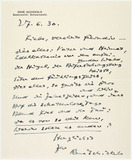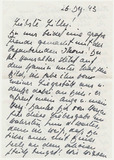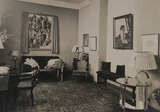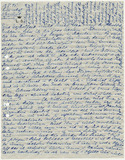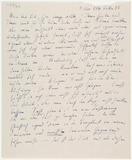Lilly Bertha Dorothea von Schnitzler
Lilly Bertha Dorothea von Schnitzler
| Born | on 25 June 1889 in Cologne, Germany |
|---|---|
| Died | on 26 June 1981 in Murnau, Germany |
| Profession | Sammlerin |
Introduced by Wilhelm Hausenstein in the mid-1920s in Frankfurt am Main, Lilly von Schnitzler and Max Beckmann developed a life-long friendship. Through Lilly von Schnitzler and her husband, Beckmann met many of the leading personalities of the contemporary art scene. In cosmopolitan spa towns like Baden-Baden and Abano Terme where the painter liked to relax, the collector set up encounters with some important contacts. Even after Beckmann was declared “degenerate” by the Nazis, Lilly von Schnitzler continued to buy his paintings, and even visited him twice in his Amsterdam exile; a recording exists of her oral recollections of the second visit.
She brokered the commission for the illustration of Goethe's Faust II in 1943/44 as well as that for Apokalypse in 1941/42 and was thus an important source of support for the painter, who during his exile lived without a regular income and had to work in semi-secrecy. Beckmann depicted his patroness in a number of portraits. Lilly von Schnitzler is – alongside his two wives – one of the five women immortalised by the painter in his 1935 painting Großes Frauenbild [Large Painting of Women]. She herself owned 22 Beckmann paintings from the years 1924 to 1949.
Der Befreite [The Liberated Convict] from 1937 was one of the central works of Beckmann's exile period owned by Lilly von Schnitzler. Speaking of this – above all against the backdrop of contemporary events – important work in late May 1939, Max Beckmann wrote to Quappi from Abano, Italy, to which Lilly von Schnitzler had invited him from Amsterdam, that she was doing him a “truly huge” service: “in this sad Germany, she has even hung The Liberated Convict at her house and shows it to everyone – this at least – to all sorts”. (ed. trans.)
Lilly von Schnitzler ultimately sold just under half of her Beckmann paintings – far below the going price at the time – to the Wallraf-Richartz Museum in Cologne, from which they were later transferred to the Museum Ludwig.
On 8 February 1953, one of two founding meetings of the Max Beckmann Gesellschaft (today: "Freunde des Max Beckmann Archivs e. V.") took place in her Bavarian residence in Murnau, “Haus Lilamor”. Lilly von Schnitzler was on the board of the first Max Beckmann Gesellschaft and was its treasurer.


